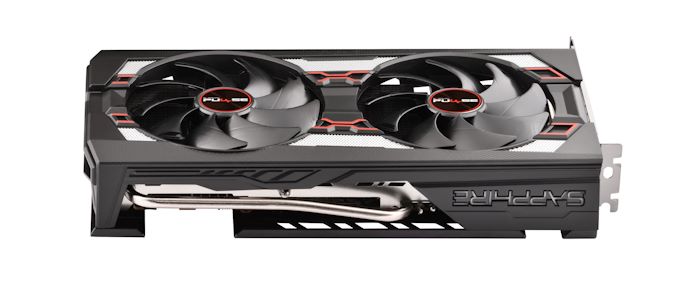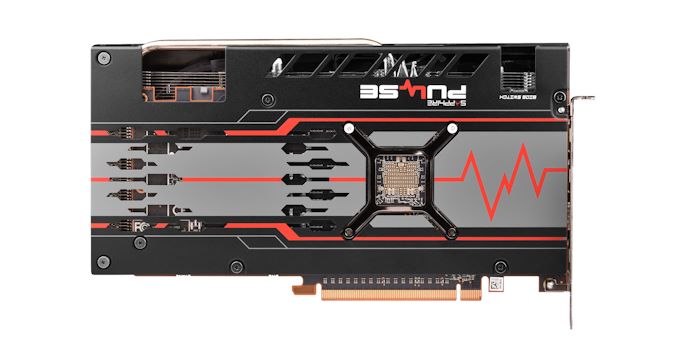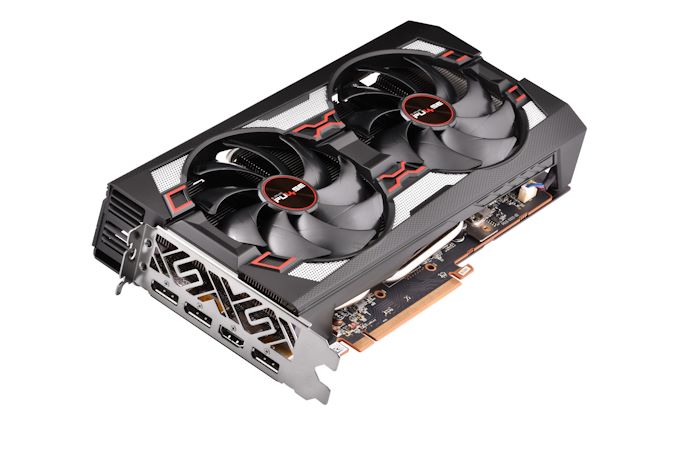The AMD Radeon RX 5600 XT Review, Feat. Sapphire Pulse: A New Challenger For Mainstream Gaming
by Ryan Smith on January 21, 2020 9:01 AM ESTMeet the Sapphire Pulse Radeon RX 5600 XT
Shifting gears, let’s talk about the actual hardware that will be hitting retail shelves today. As I mentioned towards the start of the article, AMD isn’t launching an official reference RX 5600 XT, so today’s launch is all about partner cards. To that end, AMD has sampled us with Sapphire’s Pulse RX 5600 XT. Sapphire’s card is a moderately factory overclocked card, and following AMD’s BIOS changes, is apparently a good example of what AMD wants other partner factory overclocked cards to be like.
| Radeon RX 5600 XT Card Comparison | |||||
| Radeon RX 5600 XT (Reference Specification) |
Sapphire Pulse RX 5600 XT (Quiet Mode) |
Sapphire Pulse RX 5500 XT (Default/Perf Mode) |
|||
| Base Clock | 1290MHz? | 1290MHz | 1290MHz | ||
| Game Clock | 1375MHz | 1460MHz | 1615MHz | ||
| Boost Clock | 1560MHz | 1620MHz | 1750MHz | ||
| Memory Clock | 12Gbps GDDR6 | 12Gbps GDDR6 | 14Gbps GDDR6 | ||
| VRAM | 6GB | 6GB | 6GB | ||
| TBP | 150W | ~150W | ~180W | ||
| GPU Power Limit (TGP) | N/A | 135W | 160W | ||
| Length | N/A | 10-inches | |||
| Width | N/A | 2.3-Slot | |||
| Cooler Type | N/A | Open Air, Dual Fan | |||
| Price | $279 | $289 | |||
Editor's Note: These are the specs post-BIOS update. Anyone buying the Pulse in January will want to make sure to update their card with Sapphire’s new BIOSes
Sapphire has several sub-brands of cards, including the Nitro and the Pulse. Normally the Nitro cards are their higher-priced factory overclocked cards, while the Pulse cards are more straightforward. But following AMD’s BIOS changes, that seems to have at least partially gone out the window. In any case, even with its factory overclock the Sapphire Pulse RX 5600 XT is not being positioned as a high-end card among RX 5600 XTs; at $289, it carries just a $10 premium over AMD’s MSRP.
For their Pulse RX 5600 XT cards, Sapphire has opted to factory overclock both modes for the card. The card’s default mode, which is its performance mode, ships with a ~180W TBP. This affords a rather sizable 240MHz (17%) increase in the card’s rated game clock. Meanwhile the memory clock has been increased by 2Gbps (17%) to 14Gbps. In short, in performance mode the Pulse is noticeably more powerful (and power-hungry) than a baseline RX 5600 XT.
On the flip side of the coin is the card’s quiet mode BIOS. This BIOS uses settings much closer to AMD’s own reference specs, with the 150W TBP and 12Gbps matching AMD’s. The only change here is that the card gets a milder 85MHz (6%) factory overclock, as far as the game clock is concerned.
Digging into the card, it’s clear from the start that Sapphire has overbuilt the card, particularly for cooling performance. At 10-inches long the card isn’t especially lengthy, but Sapphire makes up for that with a 2.3-slot wide cooler design and significantly taller (5.3-inch) frame. Comparing it to NVIDIA’s relatively compact dual-fan GeForce RTX 2060 Founders Edition, the Sapphire Pulse RX 5660 XT has about 50% more volume. Which, along with making the card a bit of a pain to install, affords it a lot more volume for heatsinks and fans.
The payoff for this oversized design is that Sapphire can use larger, lower RPM fans to minimize the fan noise. The Pulse 5600 XT packs 2 95mm fans, which in our testing never got past 1150 RPM. And even then, the card supports zero fan speed idle, so the fans aren’t even on until the card is running a real workload and starts warming up. The net result is that the already very quiet card is completely silent when it’s idling.
Meanwhile beneath the fans is a similarly oversized heatsink, which runs basically the entire length and most of the height of the board. A trio of heatpipes runs from the core to various points on the heatsink, helping to draw heat away from the GPU and thermal pad-attached GDDR6 memory. The fins are arranged horizontally, so the card tends to push air out via its I/O bracket as well as towards the front of a system. The card also comes with a metal backplate – no doubt needed to hold the oversized cooler together – with some venting that allows air to flow through the heatsink and out the back of the card.
Feeding the beast is an 8-pin external PCIe power cable, as well as PCIe slot power for its electricity needs. From a practical perspective this is well-provisioned for a card that will hit 180W, and with the design presumably being recycled from a 5700 series design, there’s room for a second power connector if Sapphire ever needed it.
Finally for hardware features, for display I/O we’re looking at a pretty typical quad port setup. Sapphire has equipped the card with 3x DisplayPort 1.4 outputs, as well as an HDMI 2.0b output. With daisy chaining or MST splitters, it’s possible to drive up to 6 monitors from the card.














202 Comments
View All Comments
cmdrmonkey - Friday, January 24, 2020 - link
And forgive me if I left any cards out. There are a lot of roughly $200-300 cards that are okay for 1440p gaming.Korguz - Friday, January 24, 2020 - link
can you explain it ???cmdrmonkey - Friday, January 24, 2020 - link
I can't actually. I think affordable 1440p gaming has been well covered already by plenty of new and used video cards.Korguz - Friday, January 24, 2020 - link
not every one games at 1440pcmdrmonkey - Friday, January 24, 2020 - link
What point are you trying to make? I'm trying to make the point that this is another dumb product that has no reason for existing, just like RX 5500. AMD should be focusing on winning back the high-end. That's where competition is actually needed to drive down prices across the board.Korguz - Friday, January 24, 2020 - link
and nvida doesnt have.. or has released their own.. what you consider dumb products ?? how about intels plethora of cpus ?? even you should realize it.. amd, nvidia, and intel release products that for some reason dont work as they intended when made.. but instead of throwing it out.. release it as a lower tier product.. aka phenom x3.. made as an x4.. but one core was faulty... i have seen nvida do the same.. maybe thats why we had the 3 gig and 6 gig 1060....alufan - Monday, January 27, 2020 - link
whilst being competitive in the high ground may be desirable for the sake of swinging your *@** around it doesnt make for large VOLUME sales which is what AMD are after with this card unlike the average 12 year old keyboard warrior shouting look at my card its 5 FPS faster from the rooftops AMD is looking to win back the real meat and potatoes( sry veggies no insult) market, the fact nvidia have already dropped prices in response to this card makes your whole chain of thought and beliefs about this product obsolete and pointless, AMD and indeed all public company's have to justify investors faith in them and make them a decent ROI.Spunjji - Thursday, January 30, 2020 - link
"It's AMD pulling a 'me too'"...
*proceeds to name a market segment containing 4 Nvidia GPUs (3 current gen) and 2 AMD GPUs (1 current gen)*
Tell us again, who's the one with superfluous products here? :| It's a crowded segment because there's high demand. AMD can't profit selling the outdated, hot, under-performing and expensive-to-manufacture Vega 56 at a discount, but it can profit from Navi. They just lowered the cost of entry to 1440p by forcing Nvidia to respond and your response is "wah, I don't like cheap graphics card".
sarafino - Friday, January 24, 2020 - link
$210? The lowest price on Newegg is $230 for a 1660S. Based on the aggregated review data for the updated 5600XT, it's 20% faster than the 1660S thanks to the performance bios. 20% for $40 more isn't bad. The 5700 is approximately 6% more performant for an additional $30 give or take a few dollars.reddit: /r/hardware/comments/esgwf1/amd_radeon_rx_5600_xt_performance_meta_review/
cmdrmonkey - Friday, January 24, 2020 - link
Most people would pick the 1660S so that they aren't dealing with the dumpster fire situation that is AMD's drivers.